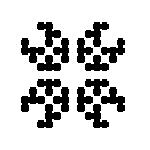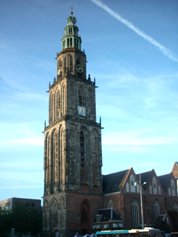Team:Groningen/Project
From 2008.igem.org
| Line 25: | Line 25: | ||
|[[Image:Grid.jpg|500px]] | |[[Image:Grid.jpg|500px]] | ||
| | | | ||
| - | The grid can be made ourselves by putting colonies on an agar plate. HSL can diffuse trough agar plates, via this the cells can communicate with eachother, and turn 'on' (alive) or 'off' (dead). | + | The grid can be made ourselves by putting colonies on an agar plate. HSL can diffuse trough agar plates, via this the cells can communicate with eachother, and turn 'on' (alive) or 'off' (dead). The exact distance and layout still needs to be determined. |
| | | | ||
|} | |} | ||
Revision as of 10:35, 6 August 2008
This year is the first year the University of Groningen is joining the iGEM competition. Our team – The Groningen Transformers – will focus on cell-cell signal systems, cellular automata and the Conway’s Game of Life!
Overall project
In our braistorm sessions we all agreed that it would be fun to create a system in Escherichia coli which could generate itself. Using such a system and a system where cells could communicate which eachother, nice patterns could be generate with that.
So we went looking for a way to use these systems together and make use of the patterns it could create. You could use this in a grid form to make games - four-on-a-row and minesweeper. However we figured out that the nicest thing to do with this, is making a cellulair automaton like the [http://en.wikipedia.org/wiki/Conway%27s_Game_of_Life Conway's game of life]. Here you only need to give an input in the beginning and the system will generate itself.
Project Details
To make a system where a cell or colony would react like a 'cell' in the Conway's game of life, a couple of things are needed:
- A interval device - Here cells need to know from its neighbours if they are 'dead' or 'alive', and when alive if its not overcrowded.
- A sender device - Cells need to let others known in what state they are: 'dead' or 'alive'.
- A receiver device - Cells need to obtain and process information from their neighbours.
- A reset function - After it gets overcrowded around one cell, it needs to reset, become 'dead'.
The Registry of Standard Parts a lot of biobricks are involved in the [http://partsregistry.org/AHL AHL quorum sensing] system of Vibrio fischeri. For our system this was really helpful, since we did not want to use a cell-cell signal system witch would interfere with E. coli's own quorum sensing system. We could use these bricks to create a system where cells will communicate with eachother and sense it at the same time. Moreover quite some other repressors and activators are present in the Registry. We chose to use the parts from the Registry as basic elements in the system. For some specific features we need to make and add them ourselves.
 "
"



